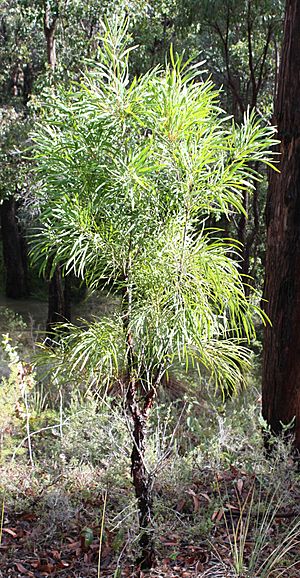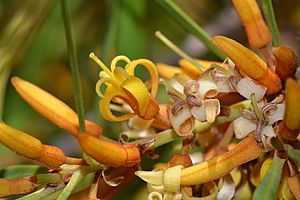Persoonia longifolia facts for kids
Quick facts for kids Snottygobble |
|
|---|---|
 |
|
| Near Nannup | |
| Scientific classification | |
| Genus: |
Persoonia
|
| Species: |
longifolia
|
| Synonyms | |
|
|
The Snottygobble (scientific name: Persoonia longifolia) is a cool flowering plant found only in the southwest part of Western Australia. It belongs to the Proteaceae plant family. This plant is usually a shrub or a small tree. You can spot it by its droopy leaves, bright yellow flowers, and unique bark that peels off in flakes.
Contents
What Does Snottygobble Look Like?
The Snottygobble is a shrub or small tree that usually grows between 1 and 5 meters (about 3 to 16 feet) tall. It often has just one main trunk.
Its bark is flaky and papery. It looks brown or grey on the outside, but if you peel it back, it's reddish-purple underneath! Young branches are covered in soft, rust-colored hairs.
Leaves and Flowers
The leaves are long and narrow, like a spear, measuring 80 to 200 mm (about 3 to 8 inches) long and 2 to 16 mm (less than an inch) wide.
The bright yellow flowers grow in groups of up to thirty. They hang on stalks up to 70 mm (about 2.7 inches) long near the ends of the branches. Each flower has its own small stem, called a pedicel, which is 4 to 12 mm long. The flower petals, called tepals, are 10 to 16 mm long.
Fruit
Snottygobble flowers from October to January. After flowering, it grows a smooth, fleshy fruit called a drupe. This fruit is 7.5 to 10 mm long and 6 to 7.5 mm wide. It ripens from July onwards and contains a single seed inside.
Where Does Snottygobble Grow?
Snottygobble is found only in the southwest of Western Australia. It grows within 70 kilometers (about 43 miles) of the coast. You can find it between the city of Albany and the southeastern edges of Perth.
It likes to grow in forests where trees like jarrah, karri, marri (Corymbia calophylla), and tingle (Eucalyptus jacksonii) are common.
Life Cycle and Ecology
Snottygobble is very tough! After a bushfire, it can grow back from special buds under its bark (called epicormic buds) or from a woody swelling at its base (called a lignotuber). This often happens several months after the fire.
Growth and Flowering Times
Scientists have studied this plant's life cycle. They found that Snottygobble grows, flowers, and produces fruit during the summer months.
Flowering starts in October and finishes by January. The most flowers appear in November and December.
Pollinators
During studies, the only creatures seen helping the Snottygobble flowers make seeds were native bees and the introduced honey-bee. These insects carry pollen from one flower to another.
Animals and Fruit
The ripe fruit of the Snottygobble falls from late July to September. Many animals enjoy eating these fruits, including wallabies, kangaroos, and the bobtail skink (Tiliqua rugosa).
If animals don't eat the fruit, the fleshy part either rots away or dries up.
Seed Germination
Snottygobble seeds usually sprout in late winter to early spring. These seeds come from the fruits produced in the previous season. The local weather conditions, like how much moisture is in the air and soil, are very important for how many seeds will sprout.
Even when seeds do sprout, not many young plants survive. Most seedlings die because they dry out or because animals graze on them.
Conservation Status
The Western Australian Government's Department of Parks and Wildlife says that the Snottygobble is "not threatened." This means it's not currently in danger of disappearing.
Uses of Snottygobble
Snottygobble is used for a few interesting things:
- It helps restore land at old mine sites.
- Its branches are popular in the cut-flower business because of their droopy look and how long they last.
- It could also be a good plant for nurseries to sell. People like its neat shape, weeping leaves, and cool flaky bark.
However, getting Snottygobble seeds to sprout can be tricky. Studies suggest that the seeds need to be buried in soil for at least eighteen months before they will germinate.
- Discovering The Hills Forest. Part of an Environmental Education Program on the Western Australian Jarrah Forest for Year 6 and 7 students. Department of Conservation and Land Management (CALM). p 44.
Images for kids
See also
 In Spanish: Persoonia longifolia para niños
In Spanish: Persoonia longifolia para niños




